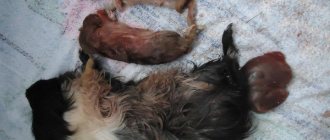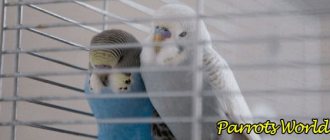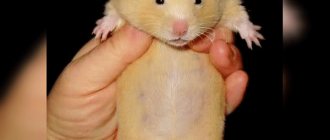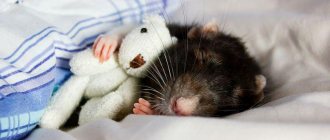- home
- Reproduction
11/09/2018 The birth of offspring is an important stage in the life of any pet. Undoubtedly, happy owners of pet hamsters are also concerned about the issues of pregnancy and childbirth of pets. Every owner of a cute pet fluffy needs to carefully prepare - study the question of how hamsters give birth, learn everything about the course of pregnancy, childbirth and postpartum care for the female.
How are hamsters born?
These furry animals are distinguished by very fast births. During the birth process, it can be noted that the expectant mother takes a sitting position and twists during contractions. Females help themselves during childbirth by extracting the fetus using their teeth.
The time between the birth of babies is very short and does not take more than two minutes. During the entire period of labor, the female gnaws through the membranes of the fruit so that the newborn baby has the opportunity to breathe, then she gnaws the umbilical cord and cleans the baby. After this, the hamster eats the placenta and amniotic sac.
Signs of impending labor:
- the female becomes slow, her activity decreases;
- there is a loss or decrease in appetite;
- the birth canal opens.
It is important to know that the average pregnancy of hamsters lasts about 20 days , this time may vary slightly depending on the type of rodent and the conditions under which it is kept.
What to feed them?
At first, while they are in the nest, the babies are fed by their mother. When they begin to crawl out of the nest, the drinking bowl needs to be lowered lower.
It will be very useful to have regular baby cereals. For example, corn, oatmeal, buckwheat. The main thing is that it does not contain sugar, flavorings, etc. A little later, you can give peeled seeds.
It wouldn't hurt, especially for mom, to have a boiled chicken egg (white). Also, high-quality grain food should be in the cage as usual.
In the near future, the babies will get stronger and begin to eat like adults.
Do not forget to promptly remove spoiled, half-eaten food.
Actions at birth
Newborn hamsters do not have fur, so they may have problems with thermoregulation. The hamster takes care of them at this time, so the owner must provide her with this opportunity. In order for the new mother to have the opportunity to build a nest, it is necessary to put materials in the cage, such as paper towels or napkins. It is advisable that the temperature in the house be 21–25 degrees.
Since a hamster is a wild animal, the female does not require human assistance during childbirth; basically, everything goes smoothly and in a short period of time.
But if you see that the hamster cannot cope on her own, for example, when there are too many fruits, you can provide her with all possible help.
You need to take a paper towel and wrap your newborn baby in it, carefully remove the mucus and membranes of the fetus. Then a gentle massage is performed and the umbilical cord is cut. It should be cut off slightly away from the abdomen. Then you need to place the baby with the others, mixing him with other babies.
Sometimes it happens that a hamster eats its offspring after giving birth; in this case, you cannot interfere; the only help is to offer the female food rich in protein. This way it will be possible to save some newborns.
It is very important that the female feeds the offspring. It must be remembered that childbirth is a complex and exhausting process, so you need to give mommy the opportunity to rest for at least four hours. If all is well, the female will allow the babies to approach her nipples within half an hour. If she does not do this and does not show care for the offspring at all, it is recommended to isolate her with the brood to prevent her from escaping.
When can you pick it up?
If grown-up dzhungarikas are not taught to handle hands, they will later bite. You can begin training from the moment their eyes open and the mother stops collecting them around the cage, sending them to the nest. At this time, they are already quite independent and will be able to survive if their mother abandons them.
Did you know? In the ancient Avestan language, the word “hamster” meant “an enemy who cast down to the ground,” since in the wild these animals obtain plant seeds by bending them to the ground.
Complications during and after childbirth
Just like humans, animals have complications during pregnancy and childbirth.
Toxicosis
Unlike people, a hamster can die from toxicosis. Unfortunately, there is no panacea for this. Toxicosis develops in rodents during childbirth or in the first days after it; this complication leads to the death of not only the mother, but also the offspring.
Pathologies of childbirth
Hamsters have a time that is most favorable for reproduction. It is not recommended to breed hamsters that are older than 10 months. This is due to the risks arising from the loss of elasticity of the pelvic bones, which makes it very difficult for a female hamster to give birth. If there are few fetuses - 1-3 babies, this threatens that they will be large, and it is very difficult for the female to give birth to such a fetus, and even strong contractions of the uterus do not help push the fetus out. If you notice that the female has been pushing for more than 10 minutes, but there is still no fetus, most likely this is exactly this case, and in order to save the animal, surgical intervention is necessary - a caesarean section.
Between the appearance of the babies, the female can rest or have a snack - this is normal, the main thing is that the contractions are productive and after pushing the fetus appears.
Fetal death
This complication is very dangerous for the expectant mother; the death of the fetus inside the uterus threatens with sepsis. To save the animal, hysterectomy is necessary.
This complication occurs for several reasons:
- Infections.
- Poor nutrition.
- Genetic diseases.
Endometritis
After giving birth, the female undergoes a process of contraction and cleansing of the uterus, which is accompanied by bloody discharge from the birth canal - this is normal.
Signs that should alert you and require consultation with a doctor:
- The discharge lasts more than three days.
- The discharge gives off an unpleasant odor.
- There is severe bleeding.
This may indicate not only endometritis, but also a remaining placenta or the presence of a dead fetus.
Mastitis
During lactation, females may experience problems with the nipples or mammary glands. Symptoms that should alert you:
- Unnatural enlargement of the mammary glands.
- Their redness.
- Lack of appetite.
- Fever.
Planned replenishment
Even during pregnancy, you need to take care of proper nutrition. At this time, the expectant mother requires a lot of protein, which goes towards the birth of new lives in the womb. In addition, provide plenty of fresh vegetables and fruits, but do not forget about solid foods. At this time, the hamster can eat and drink a lot, as the body spends a colossal amount of energy. The drinking bowl should always be full of fresh, clean water. Don't take it from the tap; spring water is better. In the pipeline, a lot of bleach is mixed into it, which has a very negative effect on the health of the animal. Of course, she should be alone in the cage. Partner interference always causes stress and anxiety.
Feeding the female after giving birth
Pregnancy, childbirth and feeding are a burden on the animal’s body, and sometimes even with good nutrition the hamster loses weight. Therefore, the nutrition of a female who has given birth and that of an adult differs.
The volume of the grain mixture for a nursing female needs to be doubled, in addition to it, food rich in proteins needs to be added to the diet. It is necessary to give the female hamster greens daily.
Experts recommend feeding the animal several times a week with low-fat boiled meat, low-fat cottage cheese or a boiled egg. It is also advisable to pamper your hamster with seeds or nuts.
It is important to remember that babies will also be introduced to food together with their mother, so the food must be crushed.
In addition to proper nutrition, your hamster needs more water. It is necessary to ensure that there is fresh water in the drinking bowl at all times.
When can you be separated from your mother?
It is time to separate three-week-old hamsters from their mother; this should be done no later than 4 weeks after birth. At this time, the female may become aggressive towards the children and may even eat them. To exclude the possibility of early reproduction, females are planted separately from males. Otherwise, there is a high probability of getting defective offspring or a lack of maternal instinct in a too young female.
The living conditions should be the same as for adult hamsters: a cage with feeders, drinkers, a house, etc. After 2 months, each hamster will have to be provided with a separate cage, otherwise “wars” for territory will begin.
Abandoned hamsters
If the mother abandoned the newborns, the owner will have to raise the babies himself.
Taming
In cases where the owner fed the babies on their own, they immediately grow up tame. Hamsters fed by their mother are allowed to be picked up only after 15 days, when the female stops worrying about protecting the offspring. You will have to be careful so that the animal does not fall, since a blow can lead to death. You shouldn’t squeeze babies either; their fragile bones are easy to break.
Self-feeding
If the hamster dies in childbirth or refuses to feed the cubs, the owners can place the young animals with another nurse. First, you should roll the babies in the filler from the corner where the female goes to the toilet. This way the smell of the adoptive mother will remain on the hamsters, after which she will be able to accept the cubs. If this is not possible, you will have to give milk yourself. Newborns need food every hour, so you will have to get up often during the night.
Buy a hamster milk replacer from a pet store. Dilute the mixture, strictly following the algorithm from the instructions. The liquid should be warm. Pour the mixture into a pipette or syringe without a needle. Then place the hamster in your palm and squeeze a drop of liquid onto your finger. Bring it to the rodent's nose so that it licks the food offered. Be careful to prevent the baby from choking.
After the first week, increase the interval between feedings to 2-3 hours. Gradually introduce peeled seeds and vegetables into the animals’ diet. When the eyes open, leave 2-3 additional feedings from a pipette per day. By the age of one month, hamsters will begin to feed on their own.
The owner will only have to adjust the position of the spout at the drinking bowl so that the cubs can reach it.
In order for milk to be better absorbed, it is recommended to lightly massage the newborn’s tummy in a circular motion for 2 minutes after feeding.
Artificial formulas do not contain the antibodies present in mother's milk and provide less benefit to the offspring. Because of this, the mortality rate among human-fed rodents is higher. Often, young animals deprived of mother's milk die within the first 2 weeks. As they grow older, the risk of formula-fed babies dying at an early age decreases.
Features of cultivation
Follow a number of rules to avoid harming small hamsters. Some of the litter may die even with proper care. This phenomenon is considered normal: only weak, sick individuals die.
Development of small pets
Hamsters grow and develop quickly. Already by the 2nd day of life, the skin turns pink, then darker spots appear, the color of which depends on the color of the breed. By the first week of life, reddish, gray or black fluff appears. After 1 month, the cubs will become completely independent.
Time to hold newborns
Wait until the hamster stops fiercely protecting the offspring and worrying when the owners approach. Most often, from the 15th day of life of the cubs, the mothers stop taking care of them and allow a person to touch the young animals. At an earlier age, babies can only be held if necessary. A hamster, sensing an unfamiliar smell, may abandon its newborns or kill them.
Consider the mother's temperament. If before pregnancy the female was tame and willingly contacted people, she will allow the babies to be touched earlier. In situations where the hamster was afraid of a person or showed aggression, it is better to wait longer.
Separating cubs from mother
Hamsters are ready to move into a separate cage from 3-4 weeks. Each child will have to choose a separate home. Hamsters compete for territory, they can fight, and bite each other in the fight. In addition, females are characterized by early puberty. If they live with their brothers, they can easily become pregnant.
Finding owners for rodents
You can give cubs to a new family from 4-6 weeks of life.
During this period, their diet no longer differs from the menu of adult animals.
Hamsters are allowed to be picked up, taught various tricks, and attractions installed in their cages.
New owners should be given recommendations on how to care for their pets. It is advised to share with them sawdust from the bedding in the hamster's cage. This way, in a new place, the cub will worry less and adapt faster.
You can look for new owners among friends or on special forums on the Internet. Periodically take an interest in the lives of the kids. Don't give them to people who are not ready to take responsibility for someone else's life. If a potential buyer seems unreliable, it is better to refuse him.
When the hamster is already 4 to 6 weeks old, it can be given into new hands.
Rodent nutrition
To get healthy and strong offspring, you need to properly feed the breeding hamsters before mating. Also, the quality of nutrition of a pregnant female determines whether the babies will be healthy or not. Therefore, carefully choose what to feed your pets.
Individuals should be well-fed, but not fat. Therefore, you should not abuse foods that contain fat and carbohydrates. Give preference to vitamin comas.
20-25 days before the planned mating, inspect the breeding rodents. For those that are underweight, supplement your diet with nutritious food. For those pets that have become obese, switch them to a light diet and increase physical activity (let them go for walks more often, put more toys designed for active recreation in the cage).
The daily diet of hamsters preparing for mating is as follows: 10 g of vegetables, 5 g of hay, 10 g of cereals (barley, oats, wheat), 1 g of tomato juice, 5 g of corn, 0.05 g of dry yeast.
The nuances of determining the sex of a pet
It is much easier to identify the sex of a mature hamster than of a baby. At the age of 35-40 days, the rodent’s organs are already perfectly formed; the weight of a representative of the Syrian breed is 150 g, and that of the Dzungarian breed is 50 g. During an external examination, you should pay attention to:
- “bald patch” between the anus and urethra;
- presence of nipples;
- body size.
Males have a distance between the anal and urethral openings - approximately 1.5 cm. If it is absent and the vegetation in the indicated place is sparse, then the hamster is a girl.
Where to keep the male: together with the babies or separately
If you have not done this before, the male should be removed before giving birth or immediately after the offspring appear. There is a high probability that his instincts will take over and he will eat all the cubs.
In addition, within a day the female is ready to mate again. Repeated pregnancy at this time is extremely undesirable, because it will lead to exhaustion of the hamster and can cause the death of both the mother and the newborn offspring.
You should not interfere in the lives of newborns
Pairing
To ensure that pet hamsters produce their intended offspring, keep males and females separate. The reproductive age of females ends at 1.5 years. Some individuals lose the ability to reproduce at the age of 1 year. As for the males, they are ready to mate at the age of 150 days. They retain the ability to reproduce throughout their lives.
Signs of female and male readiness for mating
Mating occurs during the female's estrus. And the last one occurs, on average, once every four days. It lasts 14 hours. But this is an average. Sometimes the heat ends 4 hours after it starts. Sometimes it lasts for 24 hours. If you place a male in a cage with a female whose heat has ended or has not yet begun, then a fight cannot be avoided. Therefore, you need to carefully monitor the behavior of your furry pet. During estrus, the hamster begins to take a characteristic mating position.
As for genetics, during estrus the female develops mucous discharge in the tail area and has a musky odor. As a rule, estrus begins in the evening. It is also common for a female to lose her appetite during estrus.
Males do not have a specific period in which they are ready to mate. If the female shows interest in him, then he is ready to mate at any time. If the female reacts aggressively, then he does not have sexual desire.
Some hamsters do not go into heat in winter. This is explained by the fact that rodents hibernate in nature. Accordingly, they do not reproduce. And if the temperature in the apartment drops below 20 degrees, natural instincts are triggered.
Article on the topic: Reproduction of Djungarian hamsters at home: information on breeding and mating
Choosing a mating site
Before hamsters begin to mate, they must be placed in the same cage. Experts recommend choosing neutral territory for mating. It does not have to be an equipped cage. A regular shoe box will do. In addition, it will be easy to get animals out of it if they start a fight. But you should not separate rodents with your bare hands. Wear old leather or thick textile gloves.
Alternatively, mating can be carried out in the male's cage. It is strictly forbidden to move a male into a female's cage. Since the female does not always allow the hamster to approach her, even during estrus, it makes sense to purchase several females.
Human actions during mating
Mating lasts from 5 minutes to several evenings. During mating, pets need to be monitored. As soon as fertilization has occurred, the female becomes aggressive. This applies even to the peaceful Djungarian rodents. So that she does not harm the male or he does not injure her during the fight, we separate the animals. If mating is divided over several evenings, place the hamsters in different cages during your absence.
After mating, we do not place the hamster with the pregnant female. Males do not have a developed paternal instinct. He will not care for a pregnant hamster and its offspring.
Pregnancy does not always occur after mating. Therefore, the procedure sometimes has to be repeated several times.
Sometimes after mating, the male, having spent a fair amount of energy, lies motionless for a long time. This is normal.
Basic principles of care
More often you have to take care not of newborns, but of their mother. If the hamster has not abandoned the cubs, it is better not to touch the offspring until they grow up. The person will be required to maintain a constant temperature in the room where the cage is located.
. The optimal range is +21…+25°C.
It is better to place food next to the cage so that a hungry female can independently get food through the bars.
Dzungariki
Don't bother the hamster. Stress and nervous tension are deadly for newborn animals.
Syrian hamsters
For this species, the rules of care in the first days of life are the same as for jungarians.











